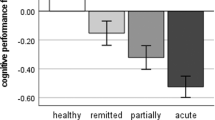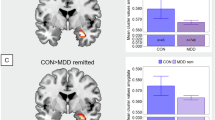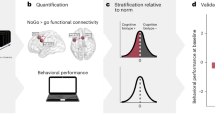Abstract
Brain metabolites of choline (Ch) and myo-Inisotol (mI) have been reported as elevated among geriatric depressed patients. Two-dimensional (2D) magnetic resonance spectroscopy (MRS) provides estimates of Ch, mI, and creatine (Cr) similar to one-dimensional MRS, and it also estimates the resonances of the Ch-containing compounds of phosphoethanolamine (Pe) and phosphocholine (PCh). In this cross-sectional geriatric study, 14 depressed patients and 14 healthy volunteers who were comparable in age, gender, education, comorbid medical burden, and Mini-Mental State Examination (MMSE) scores completed 2D MRS and a neurocognitive battery. A voxel in the left dorsolateral cortex, which was comprised of approximately 60% white matter, was used to estimate the CR ratios of Ch, PCh, Pe, and mI. Composite scores for cognitive function were developed for verbal learning, recall, recognition, executive function, hypothesis generation, and processing speed. Among nondepressed subjects, cognition was positively correlated with Ch/Cr and mI/Cr and negatively correlated with PCh/Cr in four domains of verbal learning, recognition, recall, and hypothesis generation. In contrast, depressed patients did not have consistent relationships between Ch/Cr, mI/Cr, and PCh/Cr and cognition. There was a significant difference in the overall pattern of associations between the four metabolites and verbal learning and processing speed in depressed patients compared to healthy controls. The attenuated relationship between metabolites and specific cognitive domains in patients with late-life MDD suggests that the level of cognitive performance observed during depressive episodes may be associated with changes in biochemistry within the frontostriatal neuronal circuitry.
Similar content being viewed by others
Log in or create a free account to read this content
Gain free access to this article, as well as selected content from this journal and more on nature.com
or
References
Alberts B, Johnson A, Lewis J, Raff M, Roberts K, Walter P (2002). Mol Biol Cell. Garland Science: New York. pp 583–657.
Banaker S, Venkatraman T, Yue K, Binesh N, Thomas MA (2002). Asymmetry of localized two-dimensional shift correlated MR spectroscopy. Presented at the International Conference on Mathematics and Engineering Techniques in Medicine and Biological Sciences, June 24–27, 2002, pp 500–504.
Bilder RM, Goldman RS, Robinson C, Reiter G, Bell L, Bates JA et al (2000). Neuropsychology of first-episode schizophrenia: Initial characterization and clinical correlates. Am J Psychiatry 157: 549–559.
Binesh N, Yue K, Fairbanks L, Thomas MA (2002). Reproducibility of localized correlated 2D MR spectroscopy. Magn Reson Med 48: 942–948.
Blanchard JJ, Neale JM (1994). The neuropsychological signature of schizophrenia: generalized or differential deficit? Am J Psychiatry 151: 40–48.
Brand A, Richter-Landsberg C, Leibfritz D (1993). Multinuclear NMR studies on the energy metabolism of glial and neuronal cells. Dev Neurosci 15: 289–298.
Cannon TD, Zorrilla LE, Shtasel D, Gur RC, Marco EH, Moberg PJ (1994). Neuropsychological functioning in siblings discordant for schizophrenia and healthy volunteers. Arch Gen Psychiatry 51: 651–661.
Catani M, Mecocci P, Tarducci R, Howard R, Pelliccioli GP, Mariani E et al (2002). Proton magnetic resonance spectroscopy reveals similar white matter biochemical changes in patients with chronic hypertension and early Alzheimer's disease. J Am Geriatr Soc 50: 1707–1710.
Catani M, Piccirilli M, Cherubini A, Tarducci R, Sciarma T, Gobbi G et al (2003). Axonal injury within language network in primary progressive aphasia. Ann Neurol 53: 242–247.
Chang L, Ernst T, Poland RE, Jenden DJ (1996). In vivo proton magnetic resonance spectroscopy of the normal aging human brain. Life Sci 58: 2049–2056.
Charles HC, Lazeyras F, Krishnan KRR, Boyko OB, Payne M, Moore D (1994). Brain choline in depression—in-vivo detection of potential pharmacodynamic effects of antidepressant therapy using hydrogen localized spectroscopy. Prog Neuropsychopharmacol Biol Psychiatry 18: 1121–1127.
Delis DC, Kramer JH, Kaplan E, Ober BA (1987). California Verbal Learning Test: Adult Version. The Psychological Corporation: San Antonio.
Drevets WC, Raichle ME (1992). Neuroanatomical circuits in depression: implications for treatment mechanisms. Psychopharmacol Bull 28: 261–274.
Elderkin-Thompson V, Kumar A, Bilker WB, Dunkin JJ, Mintz J, Moberg PJ et al (2003a). Neuropsychological deficits among patients with late-onset minor and major depression. Arch Clin Neuropsychol 615: 1–21.
Ernst T, Chang L, Jovicich J, Ames N, Arnold S (2002). Abnormal brain activation on functional MRI in cognitively asymptomatic HIV patients. Neurology 59: 1343–1349.
Folstein MF, Folstein SE, McHugh PR (1975). ‘Mini Mental State’: a practical method for grading the cognitive state of patients for the clinician. J Psychiatr Res 12: 189–198.
Fuster J (2000). Executive frontal functions. Exp Brain Res 133: 66–70.
Fuster J (2001). The prefrontal cortex—an update: time is of the essence. Neuron 30: 319–333.
Gadian DG (1995). N-acetylaspartate and epilepsy. Magn Reson Imaging 13: 1193–1195.
Goldman-Rakic PS (1995). Architecture of the prefrontal cortex and the central executive. In Grafman J, Boller F, Holyoak K (eds). Structure and Functions of the Human Prefrontal Cortex. New York Academy of Sciences: New York. pp 71–83.
Govindaraju V, Young K, Maudsley AA (2000). Proton NMR chemical shifts and coupling constants for brain metabolites. NMR Biomed 13: 129–153.
Hamakawa H, Kato T, Murashita J, Kato N (1998). Quantitative proton magnetic resonance spectroscopy of the basal ganglia in patients with affective disorders. Eur Arch Psychiatry Clin Neurosci 248: 53–58.
Hamilton MA (1960). A rating scale for depression. J Neurol Neurosurg Psychiatry 23: 56–62.
Heaton RK, Chelune GJ, Talley JL, Kay GG, Curtiss G (1993). Wisconsin Card Sorting Test Manual. Psychological Assessment Resources Inc.: Odessa, FL.
Hida K, Kwee IL, Nakada T (1992). In vivo H-1 and P-31 Nmr-spectroscopy of the developing rat-brain. Magn Reson Med 23: 31–36.
Huang W, Alexander GE, Daly EM, Shetty U, Krasuski JS, Rapoport SI et al (1999). High brain myo-Inositol levels in the predementia phase of Alzheimer's disease in adults with down's syndrome: a 1H MRS study. Am J Psychiatry 156: 1879–1886.
Kantarci K, Jack Jr CR, Xu YC, Campeau NG, O'Brien PC, Smith GE et al (2000). Regional metabolic patterns in mild cognitive impairment and Alzheimer's disease: a 1H MRS study. Neurology 55: 210–217.
Kollokian V (1996). Performance Analysis of Automatic Techniques for Tissue Classification in Magnetic Resonance Images of the Human Brain (Master's thesis). Concordia University, Department of Computer Science: Montreal.
Kumar A, Cook IA (2002). White matter injury, neural connectivity and the pathophysiology of psychiatric disorders. Dev Neurosci 24: 255–261.
Kumar A, Thomas A, Lavretsky H, Yue K, Huda A, Curran J et al (2002). Frontal white matter biochemical abnormalities in late-life major depression detected with proton magnetic resonance spectroscopy. Am J Psychiatry 159: 603–636.
Lezak MD (1995). Neuropsychological Assessment. Oxford University Press: New York.
Linn BJ, Linn BW, Gurel L (1968). Cumulative Illness Rating Scale. J Am Geriatr Soc 16: 622–626.
Lopez-Villegas D, Lenkinski RE, Frank I (1997). Biochemical changes in the frontal lobe of HIV-infected individuals detected by magnetic resonance spectroscopy. Proc Natl Acad Sci USA 94: 9854–9859.
Mesulam M-M (2000). Principles of Behavioral and Cognitive Neurology. Oxford University Press: New York.
Miller BL (1991). A review of chemical issues in 1H NMR spectroscopy: N-acetyl-L-aspartate, creatine and choline. NMR Biomed 4: 47–52.
Miller BL, Chang L, Booth R, Ernst T, Cornford M, Nikas D et al (1996). In vivo 1H MRS choline: correlation with in vitro chemistry/histology. Life Sci 58: 1929–1935.
Mitrushina MN, Boone KB, D'Elia LF (1999). Handbook of Normative Data for Neuropsychological Assessment. Oxford University Press: New York.
Pfefferbaum A, Adalsteinsson E, Spielman D, Sullivan EV, Lim KO (1999). In vivo spectroscopic quantification of the N-acetyl moiety, creatine, and choline from large volumes of brain gray and white matter: effects of normal aging. Magn Reson Med 41: 276–284.
Price JL (2001). Networks within the orbital and medial prefrontal cortex. Neurocase 5: 231–241.
Rajkowska G (2000). Postmortem studies in mood disorders indicate altered numbers of neurons and glial cells. Biol Psychiatry 48: 766–777.
Renshaw PF, Lafer B, Babb SM, Fava M, Stoll AL, Christensen JD et al (1997). Basal ganglia choline levels in depression and response to fluoxetine treatment: an in vivo proton magnetic resonance spectroscopy study. Biol Psychiatry 41: 837–843.
Robertson NJ, Lewis RH, Cowan FM, Allisop JM, Counsell SJ, Edwards AD et al (2001). Early increases in brain myo-Inositol measured by proton magnetic resonance spectroscopy in term infants with neonatal encephalapathy. Pediatr Res 30: 692–700.
Ross BD, Danielsen ER, Bluml S (1996). Proton magnetic resonance spectroscopy: the new gold standard for diagnosis of clinical and subclinical hepatic encephalopathy? Dig Dis 14 (Suppl 1): 30–39.
Shonk TK, Moats RA, Gifford P, Michaelis T, Mandigo JC, Izumi J et al (1995). Probable Alzheimer disease: diagnosis with proton MR spectroscopy. Radiology 195: 65–72.
Steingard RJ, Yurgelun-Todd DA, Hennen J, Moore JC, Moore CM, Vakili K et al (2000). Increased orbitofrontal cortex levels of choline in depressed adolescents as detected by in vivo proton magnetic resonance spectroscopy. Biol Psychiatry 48: 1053–1061.
Stroop JR (1935). Studies of interference in serial verbal reactions. J Exp Psychol 18: 643–662.
Styor L (1988). Introduction to biological membranes. In: Styor L (ed). Biochemistry. WH Freeman: New York. pp 283–312.
Thomas AJ, O'Brien JT, Davis S, Ballard C, Barber R, Kalaria RN et al (2002). Ischemic basis for deep white matter hyperintensities in major depression: a neuropathological study. Arch Gen Psychiatry 59: 785–792.
Thomas MA, Hattori N, Umeda M, Sawada T, Naruse S (2003). Evaluation of two-dimensional L-COSY and JPRESS using a 3 T MRI scanner; from phantoms to human brain in vivo. Nucl Magn Reson Biomed 16.
Thomas MA, Yue K, Binesh N, Davanzo P, Kumar A, Siegel B et al (2001). Localized two-dimensional shift correlated MR spectroscopy of human brain. Magn Reson Med 46: 58–67.
Warrington EK (1984). Recognition Memory Test. NFER-Nelson: Windsor, UK.
Wechsler D (1997). WAIS-III: Administration and Scoring Manual. The Psychological Corporation: San Antonio.
Acknowledgements
This research was supported by NIH Grants RO1 MH 63764, RO1 MH 61567, and KO2 MH 02043 (A Kumar, PI).
Author information
Authors and Affiliations
Corresponding author
Rights and permissions
About this article
Cite this article
Elderkin-Thompson, V., Thomas, M., Binesh, N. et al. Brain Metabolites and Cognitive Function among Older Depressed and Healthy Individuals Using 2D MR Spectroscopy. Neuropsychopharmacol 29, 2251–2257 (2004). https://doi.org/10.1038/sj.npp.1300553
Received:
Revised:
Accepted:
Published:
Issue date:
DOI: https://doi.org/10.1038/sj.npp.1300553
Keywords
This article is cited by
-
Executive functions in elderly men
AGE (2012)



